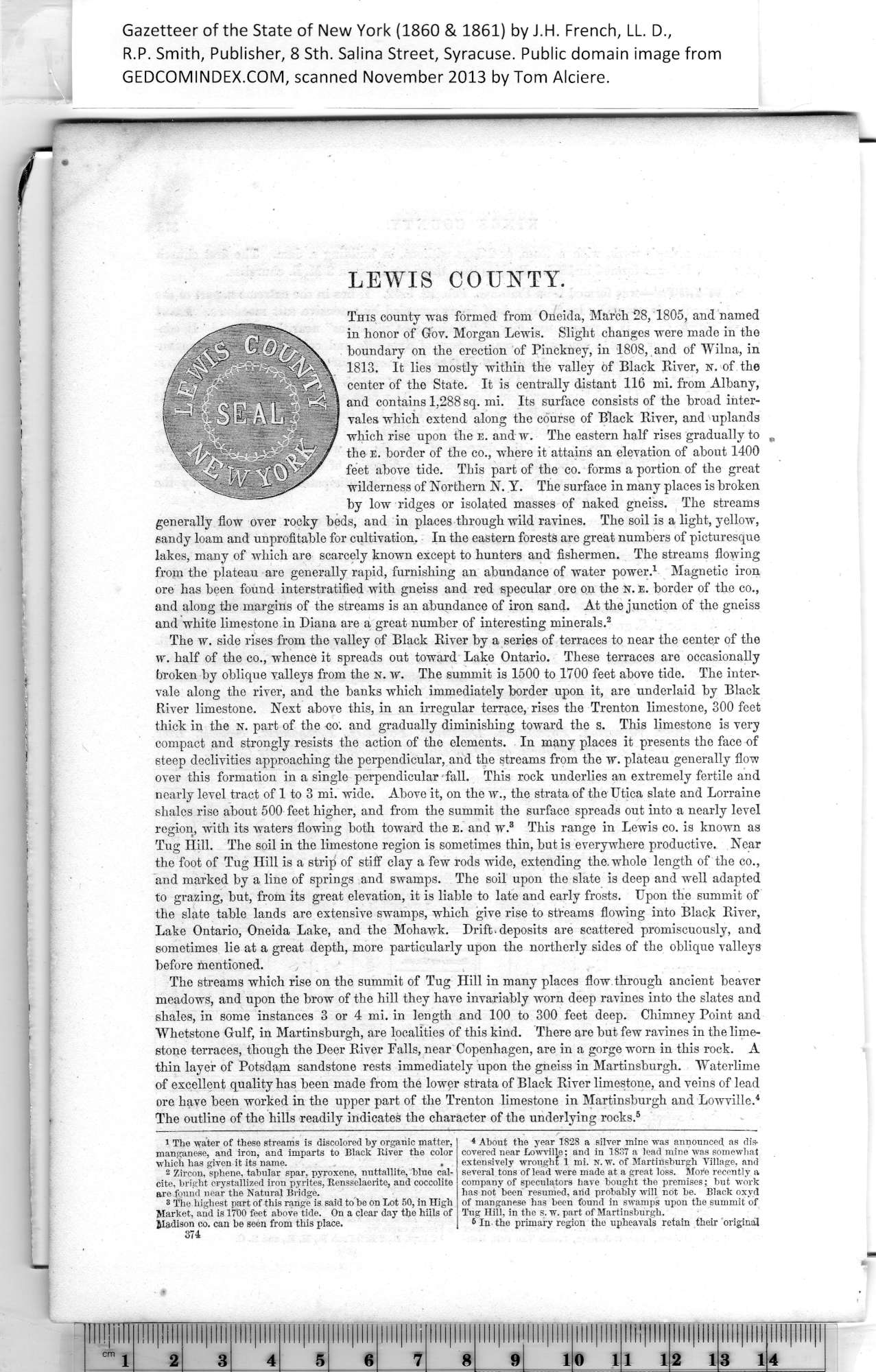|
LEWIS COUNTY.
This county was formed from Oneida, March 28, 1805, and named
in honor of Gov. Morgan Lewis. Slight changes were made in the
boundary on the erection of Pinckney, in 1808, and of Wilna, in
1813. It lies mostly within the valley of Black Biver, sr. of the
center of the State. It is centrally distant 116 mi. from Albany,
and contains 1,288 sq. mi. Its surface consists of the broad inter¬
vales which extend along the course of Black Biver, and uplands
which rise upon the e. and w. The eastern half rises gradually to
the e. border of the co., where it attains an elevation of about 1400
feet above tide. This part of the co. forms a portion of the great
wilderness of Northern N. Y. The surface in many places is broken
by low ridges or isolated masses of naked gneiss. The streams
generally flow over rocky beds, and in places through wild ravines. The soil is a light, yellow,
sandy loam and unprofitable for cultivation. In the eastern forests are great numbers of picturesque
lakes, many of which are scarcely known except to hunters and fishermen. The streams flowing
from the plateau are generally rapid, furnishing an abundance of water power.1 Magnetic iron
ore has been found interstratified with gneiss and red specular ore on the N. E. border of the co.,
and along the margins of the streams is an abundance of iron sand. At the junction of the gneiss
and white limestone in Diana are a great number of interesting minerals.2
The w. side rises from the valley of Black Biver by a series of terraces to near the center of the
w. half of the co., whence it spreads out toward Lake Ontario. These terraces are occasionally
broken by oblique valleys from the n. w. The summit is 1500 to 1700 feet above tide. The inter¬
vale along the river, and the banks which immediately border upon it, are underlaid by Black
Biver limestone. Next above this, in an irregular terrace, rises the Trenton limestone, 300 feet
thick in the N. part of the co. and gradually diminishing toward the s. This limestone is very
compact and strongly resists the action of the elements. In many places it presents the face of
steep declivities approaching the perpendicular, and the streams from the w. plateau generally flow
over this formation in a single perpendicular fall. This rock underlies an extremely fertile and
nearly level tract of 1 to 3 mi. wide. Above it, on the w., the strata of the Utica slate and Lorraine
shales rise about 500 feet higher, and from the summit the surface spreads out into a nearly level
region, with its waters flowing both toward the e. and w.3 This range in Lewis co. is known as
Tug Hill. The soil in the limestone region is sometimes thin, but is everywhere productive. Near
the foot of Tug Hill is a strip' of stiff clay a few rods wide, extending the. whole length of the co.,
and marked by a line of springs and swamps. The soil upon the slate is deep and well adapted
to grazing, but, from its great elevation, it is liable to late and early frosts. Upon the summit of
the slate table lands are extensive swamps, which give rise to streams flowing into Black Biver,
Lake Ontario, Oneida Lake, and the Mohawk. Drift, deposits are scattered promiscuously, and
sometimes lie at a great depth, more particularly upon the northerly sides of the oblique valleys
before mentioned.
The streams which rise on the summit of Tug Hill in many places flow through ancient beaver
meadows, and upon the brow of the hill they have invariably worn deep ravines into the slates and
shales, in some instances 3 or 4 mi. in length and 100 to 300 feet deep. Chimney Point and
Whetstone Gulf, in Martinsburgh, are localities of this kind. There are but few ravines in the lime¬
stone terraces, though the Deer Biver Falls, near Copenhagen, are in a gorge worn in this rock. A
thin layer of Potsdam sandstone rests immediately upon the gneiss in Martinsburgh. Waterlime
of excellent quality has been made from the lower strata of Black Biver limestone, and veins of lead
ore have been worked in the upper part of the Trenton limestone in Martinsburgh and Lowvilie.4
The outline of the hills readily indicates the character of the underlying rocks.5
|
* About the year 1828 a silver mine was announced as dis¬
covered near Lowvilie; and in 1837 a lead mine was somewhat
extensively wrought i mi. N. w. of Martinsburgh Village, and
several tons of lead were made at a great loss. More recently a
company of speculators have bought the premises; but work
has not been resumed, and probably will not be. Black oxyd
of manganese has been found in swamps upon the summit of
Tug Hill, in the s. w. part of Martinsburgh.
6 In the primary region the upheavals retain their original |
S74
1
The water of these streams is discolored by organic matter,
manganese, and iron, and imparts to Black Biver the color
which has given it its name. ,
2
Zircon, sphene, tabular spar, pyroxene, nuttallite, blue cal-
3
cite, bright crystallized iron pyrites, Rensselaerite, and coccolite
are found near the Natural Bridge.
4
8 The highest part of this range is said to he on lot 50, in High
Market, and is 1700 feet above tide. On a clear day the hills of
5
Madison co. can be seen from this place.
|
